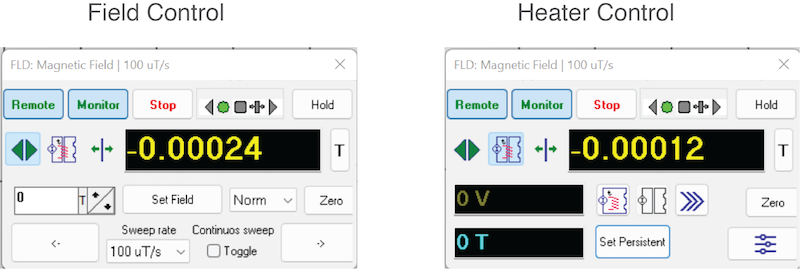Two types of magnets are commonly used in EPR spectroscopy:
- H-Frame Electromagnets
- Superconducting Magnets
Most Bridge12 EPR spectrometers are equipped with a superconducting magnet. Both magnet types can be controlled through SpecMan4EPR.
This is the multi-page printable view of this section. Click here to print.
Two types of magnets are commonly used in EPR spectroscopy:
Most Bridge12 EPR spectrometers are equipped with a superconducting magnet. Both magnet types can be controlled through SpecMan4EPR.
The following instructions are specific to how the magnetic field is controlled through SpecMan4EPR. Instructions for cooling down the magnet can be found in the Magnet Section of the Systems Menu.
Superconducting magnets can produce extremely high magnetic fields. Avoid any metal objects around the magnet. Always operate around the magnet with care.
Please check with your local facility manager about safety procedures when working with superconducting magnets.
Superconducting magnets used in Bridge12 EPR spectrometers come with an integrated heater switch so the magnet can be operated in a driven-mode or in persistent mode. If the magnet switch is closed, the magnet is in persistent mode, similar to superconducting magnets. While the magnet will have the lowest drift rate in persistent mode, generating a very stable field, the field can not be swept/changed. To sweep the magnetic field, the heater has to be activated to open the switch.
A typical scenario to put the magnet in persisten mode at e.g. 5 T would look like this:
Contrary to what is done in NMR spectroscopy, do not disconnect the power supply from the magnet, once the magnet is set to persistent mode.
At the end of this procedure this the magnet is in a 5 T persistent field state and the drift will be very low. To change the field, first the magnet leads need to be ramped up to match the current in the magnet.
If the magnet is “parked” at a non-zero field and is in persistent mode, the current in the leads has to be ramped up to match the current in the magnet coil to avoid quenching or possible damage to the magnet.
The superconducting magnet power supply will not allow the user to activate the heater if the current in the leads does not match the current of the magnet coil.
If you encounter any problems please contact Bridge12 at support@bridge12.com.
The superconducting magnet can be completely controlled through the SpecMan4EPR software using the. From the SpecMan magnet GUI the user can activate the heater switches, move/sweep the magnet field, and can put the magnet in persistent mode.
To launch the magnet GUI:
The following window will appear:

The magnet control window has three different buttons to select the functionality:
To change the magnetic field first the superconducting heater needs to be activated. This will connect the magnet power supply to the main coil and will allow the user to increase or decrease the current in the main coil and therefore moving the magnetic field.

The value of the magnetic field is shown in two different colors, depending if the heater switch is activated or not:
The switch in the superconducting magnet is thermally activated. When activating the heater (switching the heater on) the user should wait for 10-20 seconds until the switch is fully opened. To be sure the switch is fully openend, the user can check the heater switch temperature in the logging GUI.
To open the superconducting switch:
To open the superconducting switch:
To close the superconducting switch:
Depending on the type of experiment the magnet field is either:
Typically, when switching on the spectrometer, the user would set a field value close the start value. This is not strictly required but will speed up operations when the field is moved a lot during an experiment session.
Once an initial value is set the field is entirely controled by SpecMan4EPR.
To prepare for an experiment:
It is completely fine to leave the magnet at field, if the spectrometer is not used for a short time. However, if the spectrometer is not used for a while, the magnetic field should be discharged. To ramp down the magnet:
Unless the spectrometer is not used for several days, the Helium compressor will be constantly running and is not turned off, when the spectrometer is switched off. Keep in mind, it takes about 24 hrs to cool down the magnet from room temperature.
When sweeping or changing the magnetic field, the rate, at which the magnetic field is changed, can not exceed a specific value. This value for the sweep rate is given by the magnet manufacturer. It is common for superconducting magnets to have different sweep rates for different field value regimes.